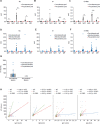IgG3 and IgM Identified as Key to SARS-CoV-2 Neutralization in Convalescent Plasma Pools
- PMID: 34982806
- PMCID: PMC8726489
- DOI: 10.1371/journal.pone.0262162
IgG3 and IgM Identified as Key to SARS-CoV-2 Neutralization in Convalescent Plasma Pools
Abstract
Analysis of convalescent plasma derived from individuals has shown that IgG3 has the most important role in binding to SARS-CoV-2 antigens; however, this has not yet been confirmed in large studies, and the link between binding and neutralization has not been confirmed. By analyzing plasma pools consisting of 247-567 individual convalescent donors, we demonstrated the binding of IgG3 and IgM to Spike-1 protein and the receptor-binding domain correlates strongly with viral neutralization in vitro. Furthermore, despite accounting for only approximately 12% of total immunoglobulin mass, collectively IgG3 and IgM account for approximately 80% of the total neutralization. This may have important implications for the development of potent therapies for COVID-19, as it indicates that hyperimmune globulins or convalescent plasma donations with high IgG3 concentrations may be a highly efficacious therapy.
Conflict of interest statement
I have read the journal’s policy and the authors of this manuscript have the following competing interests: All authors are employees of CSL Behring. This does not alter our adherence to PLOS ONE policies on sharing data and materials
Figures




References
MeSH terms
Substances
LinkOut - more resources
Full Text Sources
Medical
Miscellaneous

